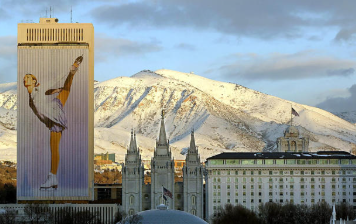In under twenty years, Salt Lake City has transformed from a winter sports venue to a thriving technological hub, capitalizing on the legacy of the 2002 Winter Olympics to become one of the fastest-growing corporate destinations in the United States.
Known as one of Utah’s “Silicon Slopes,” the community has drawn venture money, a thriving workforce, and an enterprising culture. According to the Census Bureau, the population has grown by 10% and salaries have surged by 51% during the last ten years.
The Olympics, according to former Utah Governor Michael Leavitt, sparked significant infrastructural investments in Salt Lake City, brought in tech expertise, and left an economic legacy that still influences the identity of the area.
“The Games served as a powerful stimulant. For the forthcoming “Cities of Success: Salt Lake City” special, which premieres Tuesday at 10 p.m. ET, Leavitt told CNBC that “big economic growth needs a catalyst like that.”

An engine of economic expansion
The globe watched as Salt Lake City hosted the Winter Olympics in 2002, welcoming both competitors and fans. Leavitt, the governor from 1993 to 2003, however, saw the Games as much more than just 17 days of athletic spectacle.
“The Games’ 17 days are crucial,” Leavitt stated. “But what really makes the Games a worthwhile experience, both economically and culturally, is what happens in the seven or eight years leading up to the Games and in the ten years following.”
The Olympic Oval, a top speed skating surface still frequented by would-be Olympians, is one of ten facilities used during the 2002 Games that still benefit the community and host important events.
Athletes who have set records on the multimillion-dollar facility claim that it has the “fastest ice on Earth.”
More than 4,600 feet above sea level, according to experts, lowers air resistance, which might provide skaters a speed advantage.
According to Leavitt, Utah made investments in key roadways and light rail as part of its preparation for the Games, which will benefit locals and tourists for years to come.
Leavitt told CNBC, “It’s like hosting a party at your house—a lot gets done with that deadline.” “We proved we could win when we competed against the world.”
The 2002 Olympics in Salt Lake City were profitable despite costing around $2 billion. According to the Kem C. Gardner Policy Institute at the University of Utah, the state’s budget for the Games produced a $164 million surplus, of which $59 million was given back to taxpayers.
According to the Gardner Institute, in the 15 years after the Games, tourist spending skyrocketed by 66%, hotel and accommodation income surged by 70%, and skier trips to Utah jumped by 43%.

From host of the Olympics to booming tech center
Technology was only starting to develop in the early 1990s, according to Leavitt. “We wanted to become a tech capital, but up until that point, Utah had been primarily a defense and agricultural state.”
Leavitt met with John Warnock, a Salt Lake City native and co-founder of Adobe, in Silicon Valley during Olympic preparations to talk about creating a tech ecosystem in Utah.
Leavitt remembered Warnock telling him, “I need engineers if you want [me] to come to Utah.”
Leavitt and the state of Utah started the Engineering and Computer Science Initiative in 2001 in response to Warnock’s recommendations. By increasing staff and programs, the initiative sought to enhance higher education in these areas, eventually tripling the number of graduates in computer science and engineering over a 20-year period with a total expenditure of $40.1 million.
Colleges and universities stepped up to the plate with state support, matching programs to business demands and student interests. Since then, the region’s growing demand for computer professionals has propelled both governmental and private investments.
Years later, Adobe paid $1.8 billion to purchase Utah-based Omniture, demonstrating the state’s ability to develop competitive digital companies, according to Leavitt.
“It was the combination of having a clear vision, having the Olympics and a place they wanted to live, and drastically increasing the number of engineers we were educating,” Leavitt explained. “All of that combined to create one of the nation’s most resilient technology-based economies.”
Considering 2034
Utah plans to invest an estimated $31 million in modifications to its current infrastructure in preparation for the 2034 Winter Games, which will return to Salt Lake City. This is a relatively small sum when compared to the $286.7 million invested in 2002.
According to the state, the 2018 Games will contribute roughly $3.9 billion to Utah’s economy, produce $6.6 billion in economic activity, and create 42,000 job-years of employment, which is equal to 4,200 full-time jobs over a ten-year period. These figures will further cement the Olympics’ place in Utah’s thriving tech sector.
According to Leavitt, “we now have advantages we didn’t have.” We have a reputation and all of the necessary infrastructure. 2034 will be a great year for the Games. There is simply no doubt about that.





